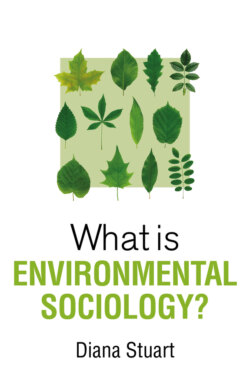Читать книгу What is Environmental Sociology? - Diana Stuart - Страница 10
Book Overview
ОглавлениеIn the following chapters, we will examine the topics, theories, and approaches that embody environmental sociology and illustrate specific contributions to understanding the social dimensions of environmental impacts, the drivers of environmental impacts, and possible solutions. Recent work will be emphasized, yet some classic studies will also be discussed. Throughout the book, we will continue to focus on the existential environmental crisis that we face related to climate change and biodiversity loss. This crisis is very real, and the risks are so great that for some of us it is difficult to think about anything else. In this book, the reality of these threats will be consistently acknowledged—as well as the moral implications of our choices moving forward. In this time of crisis, we cannot shy away from questions of morality. This focus is not intended to induce fear. It is meant to be truthful, as knowing the truth is necessary to act most effectively to minimize the impacts ahead. In addition to these existential threats, we will also examine a range of other environmental topics, including toxins, health, and environmental justice, as well as diverse examples of methodologies and public sociology.
Chapter 2 focuses on the social dimensions of environmental impacts, or the ways in which impacts are identified, perceived, framed, and communicated. It covers the contested interpretations of science, risk perception, social constructionist perspectives, as well as environmental justice. Environmental sociologists have examined why in some cases environmental impacts remain unnoticed, ignored, or tolerated, and in other cases are deemed unacceptable and demanding of immediate attention. In addition, they have identified how environmental impacts are distributed and experienced unequally, in many cases harming those who are already most vulnerable. While environmental impacts are very real in a biophysical sense, how they are perceived, framed, and understood by individuals, in the media, and throughout society determines which impacts are deemed problematic and if there will be a meaningful response.
Chapter 3 illustrates how the work of environmental sociologists has helped to identify the drivers of environmental impacts. While early and oversimplified explanations of environmental degradation focused on population growth alone, quantitative analysis has consistently revealed the important role of consumption and affluence in driving environmental impacts. Theoretical and empirical work also reveals how rising levels of consumption and affluence are being driven by a system that is growth-dependent, always producing more goods and services. This constant expansion results in increasing levels of pollution and depleted resource reserves. This chapter also describes how the concepts of the treadmill of production, the metabolic rift, and the second contradiction of capitalism contribute to our understanding of the underlying drivers of environmental degradation.
Chapter 4 focuses on possible solutions to environmental impacts, especially our escalating environmental crisis. This is the longest chapter in the book, because of the critical importance of identifying the most effective and just solutions. We will examine multiple perspectives on solution pathways. Reflexive modernization theory posits that society will respond to environmental harm through concern-driven counter-movements. Yet powerful economic and political groups continue to stymie such reflexivity. Ecological modernization theorists believe that through science, markets, and policy reform we can address environmental impacts and still support economic growth. In addition, widespread technological optimism promotes the notion that technology will be able to solve all of our environmental problems. In contrast, other scholars claim that in order to address our environmental crisis we must fundamentally change our social order. Some advocate for new priorities and policies, adopting alternative economic models, or creating a new system altogether.
Chapter 5 concludes the book by examining social movements and social transformation as well as possible areas for future work in environmental sociology. Social movements are critical for pushing forward solutions and system change. The environmental movement continues to grow, especially in response to climate change, and many groups are demanding structural social and economic changes. As these tensions increase, there will be more opportunities for environmental sociologists to understand and participate in these power struggles. In addition, as more environmental impacts inevitably unfold we need to examine the range of physical and emotional consequences, recognize and address injustices, and identify how communities can become stronger and more resilient in the face of change.
Environmental sociologists continue to do critical research that debunks false assumptions, seeks out effective and just solutions, and examines pathways for positive social transformation. Those who wish to pursue a career in environmental sociology stand poised to make important contributions to addressing our environmental challenges and identifying pathways to create a more just and sustainable world. Despite the existential threats we face and some already unavoidable impacts, there are still many possible paths forward and many ways we can do meaningful work to minimize global warming, species extinction, and human suffering. In other words, the path toward the most sustainable and just future is worth pursuing.
